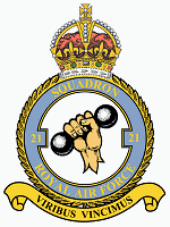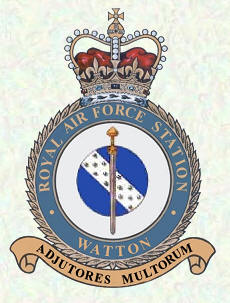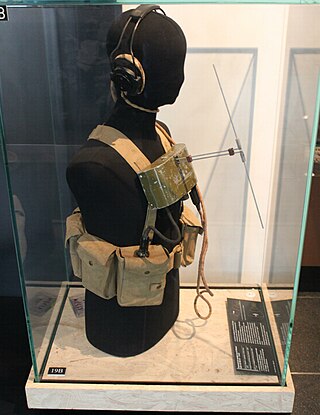The Pathfinders were target-marking squadrons in RAF Bomber Command during World War II. They located and marked targets with flares, at which a main bomber force could aim, increasing the accuracy of their bombing. The Pathfinders were normally the first to receive new blind-bombing aids such as Gee, Oboe and the H2S radar.

Oboe was a British bomb aiming system developed to allow their aircraft to bomb targets accurately in any type of weather, day or night. Oboe coupled radar tracking with radio transponder technology. The guidance system used two well-separated radar stations to track the aircraft. Two circles were created before the mission, one around each station, such that they intersected at the bomb drop point. The operators used the radars, aided by transponders on the aircraft, to guide the bomber along one of the two circles and drop the bombs when they reached the intersection.

H2X, officially known as the AN/APS-15, was an American ground scanning radar system used for blind bombing during World War II. It was a development of the British H2S radar, the first ground mapping radar to be used in combat. It was also known as the "Mickey set" and "BTO" for "bombing through the overcast" radar.
Gee-H, sometimes written G-H or GEE-H, was a radio navigation system developed by Britain during World War II to aid RAF Bomber Command. The name refers to the system's use of the earlier Gee equipment, as well as its use of the "H principle" or "twin-range principle" of location determination. Its official name was AMES Type 100.

Irving "Al" Gross was a pioneer in mobile wireless communication. He created and patented many communications devices, specifically in relation to an early version of the walkie-talkie, Citizens' Band radio, the telephone pager and the cordless telephone.

Operation Carpetbagger was a World War II operation to provide aerial supply of weapons and other matériel to resistance fighters in France, Italy and the Low Countries by the U.S. Army Air Forces that began on 4 January 1944.

Royal Air Force North Pickenham or more simply RAF North Pickenham is a former Royal Air Force station located 3 miles (4.8 km) East of Swaffham, Norfolk, England.

No. 21 Squadron of the Royal Air Force was formed in 1915 and was disbanded for the last time in 1979.

Royal Air Force Horsham St Faith or more simply RAF Horsham St Faith is a former Royal Air Force station near Norwich, Norfolk, England which was operational from 1939 to 1963. It was then developed as Norwich International Airport.

Royal Air Force Harrington or more simply RAF Harrington is a former Royal Air Force station in England about 5.6 miles (9.0 km) west of Kettering in Northamptonshire south of the village of Harrington off the A14 road. During the early Cold War, it was a Thor missile site, designed to deliver atomic warheads to the Soviet Union. The nuclear missile site is now protected as a Grade II listed building as an example of Cold War architecture.

Royal Air Force Watton or more simply RAF Watton is a former Royal Air Force station located 9 mi (14 km) southwest of East Dereham, Norfolk, England.

Operation Paravane was a British air raid of World War II that inflicted heavy damage on the German battleship Tirpitz, at anchor in Kaafjord in the far north of German-occupied Norway. The attack was conducted on 15 September 1944 by 21 Royal Air Force heavy bombers, which flew from an airfield in the north of the Soviet Union. The battleship was struck by one bomb, and further damaged by several near misses. This damage rendered Tirpitz unfit for combat, and she could not be repaired as it was no longer possible for the Germans to sail her to a major port.

The S-Phone system was a UHF duplex radiotelephone system developed during World War II for use by Special Operations Executive agents working behind enemy lines to communicate with friendly aircraft and coordinate landings and the dropping of agents and supplies. The system was composed of a "Ground" transceiver, designed by Captain Bert Lane, and an "Air" transceiver designed by Major Hobday, both of the Royal Signals.

The 492d Fighter Squadron, nicknamed "the Madhatters", is part of the 48th Fighter Wing at RAF Lakenheath, England, where they operate the McDonnell Douglas F-15E Strike Eagle.

The 25th Attack Group is an active United States Air Force unit, stationed at Shaw Air Force Base, South Carolina. It was activated in February 2018 as a geographically separate unit to operate unmanned aerial vehicles and is assigned to the 432d Wing, which is located at Creech Air Force Base, Nevada. As of 2020, the group manages five General Atomics MQ-9 Reaper attack squadrons, as well as the 25th Operations Support Squadron, which provides intelligence, weather, and administrative support.

The 492nd Special Operations Wing is a United States Air Forces unit stationed at Hurlburt Field, Florida. It was activated in May 2017 to replace the Air Force Special Operations Air Warfare Center.

The 36th Electronic Warfare Squadron is an active United States Air Force unit. It is stationed at Eglin Air Force Base, Florida, where it is assigned to the 350th Spectrum Warfare Wing

The de Havilland Mosquito was a British light bomber that served in many roles during and after the Second World War. Mosquito-equipped squadrons performed medium bomber, reconnaissance, tactical strike, anti-submarine warfare and shipping attack and night fighter duties, both defensive and offensive. Mosquitos were widely used by the RAF Pathfinder Force, which marked targets for night-time strategic bombing. Despite an initially high loss rate due to low-level daylight attack operations, the Mosquito ended the war with the lowest losses of any of the aircraft types in RAF Bomber Command service.

The 54th Weather Reconnaissance Squadron is an inactive United States Air Force unit. Its last assignment was to the 41st Rescue and Weather Reconnaissance Wing at Andersen Air Force Base, Guam, where it was inactivated on 30 September 1987.
















